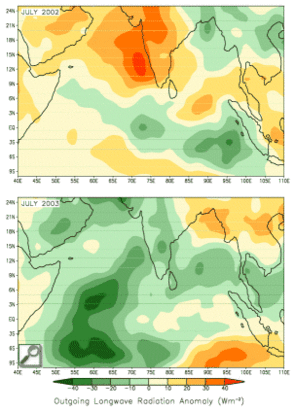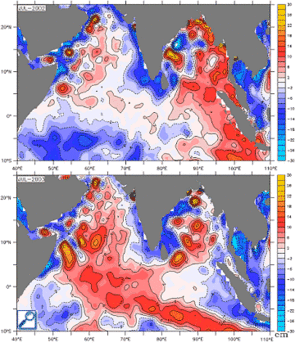Summer: wet monsoon season
Image of the month - August 2004
Sea level anomalies (right) from altimetry and outgoing longwave radiation (ORL, left, i.e. infrared radiations emitted by Earth surface or cloud top) anomalies, that contrasts the summer monsoons of 2002 and 2003.
The drought during 2002 was associated with the unfavorable phase of the Equatorial Indian Oscillation. In this phase, there is increased convection over the eastern equatorial Indian Ocean (associated with large positive anomalies in OLR over India), winds anomalies along the equator are towards west and sea level is higher in the eastern Indian Ocean. In contrast, the monsoon during 2003 was normal and the opposite phase of the Equatorial Indian Oscillation, associated with low sea level and reduced convection, can be clearly seen in the eastern Indian Ocean. (Credits Centre for Atmospheric and Oceanic Sciences -- Indian Institute of Science)
India and South East Asia are subject to the seasonal shift of the monsoon (see Image of the Month: October 2002 Summer current, winter current). Summer is the season of the wet monsoon, but drought (like in 2002, when rainfall was 19% below normal) if the monsoon is weaker than usal, or flood (like this year) if rainfalls are heavier, are always possible -- and catastrophic for the populations. Monsoons are driven by ocean temperature and winds, but the influences over those two factors are complex, and sometimes difficult to decipher. For example, El Niño and La Niña demonstrated an influence, but not systematically: other oscillations and coupled ocean-atmosphere phenomena, like the Equatorial Indian Oscillation (EQUINOO), are also important, and may be dominant over the ENSO cycles.
Long-term studies of all ocean and atmosphere parameters, including those brought by altimetry satellites, should lead to improvement in forecasting models, and thus help to prevent the worst of the "abnormal" monsoons.
See also:
- Image of the Month: October 2002 Summer current, winter current
- Applications: Climate
Websites on this subject:
References
- Gadgil, S. et al., 2004: Extremes of the Indian summer monsoon rainfall, ENSO and equatorial Indian Ocean oscillation, Geophys. Res. Lett., 31, L12213, 10.1029
- Gadgil, S., P.N. Vinayachandran and P.A. Francis, 2003: Drought of the Indian Summer: Role of clouds over the Indian Ocean, Current Science, 85, 12, 1713-1719






